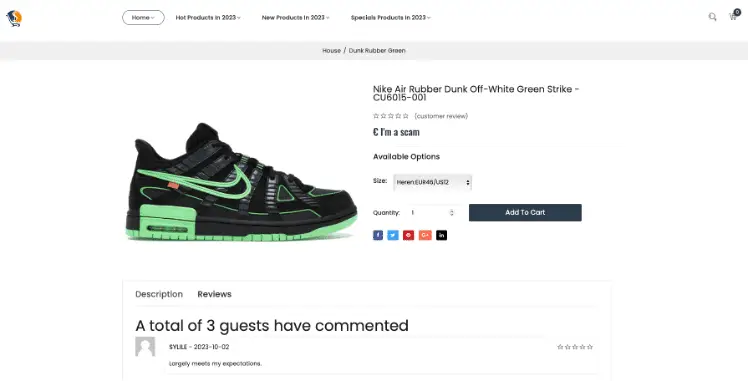Everyone loves a bargain online. Hunting down deals helps you save some cash while finding the perfect gift, whether it’s Mother’s Day, your best friend’s birthday, or you’re just buying yourself a well-earned treat.
A quick Google search reveals websites full of bargains, so you fill up the cart and head to the checkout page. Sometimes, you don’t even have to search for an online shop, as your favorite social platforms like Instagram show you tailored ads with all the clothes and electronics you need. These platforms are well established, so you can trust a shopping link you find through their apps, right? However, as soon as you hit pay, you start to fear the worst: you’ve been tricked by fake Internet shopping sites.

What are fake internet shopping sites?
Fake Internet shopping sites lure would-be customers into giving away cash and sensitive data like passwords and billing details. Complaints to the Federal Trade Commission (FTC) concerning consumer losses from fake shops quadrupled in 2020, mirroring similar spikes around the world. With losses in the US alone projected to surpass half a billion dollars, and similar figures reported in the EU, consumers and businesses must take action.
Fraudulent shopping pages come in many shapes and sizes, making them unpredictable and hard to mitigate. Scammers register thousands of fake websites under cheap domain extensions, filling them with content that’s generic enough to replicate, but tailored enough to meet your ecommerce expectations.
How do they work?
When a cybercriminal sets up a smart enough algorithm, it skims legitimate websites for trending and in-demand items, then populates fake sites with everything you’d want online. They’ll typically buy some digital ad space with a stolen credit card or PayPal account, then fill up your browser and your social media with scam ads. By borrowing credibility from mainstream providers and running tailored sites at scale on autopilot, they’re bound to trick targets and undermine legitimate ecommerce revenues for their own gain.

They either sell nothing at all, or they scam with counterfeits or dangerous substitutes. Listing everything from vehicle scams to electronics, medicines, and even fake pet adverts, fraudulent ecommerce sites wreak havoc online.
These shops thrived during lockdown, and we often raise awareness during ecommerce rushes like Christmas, Cyber Monday, or Valentine’s Day. However, the truth is that thousands of these fake sites lie in wait, undermining brands and stealing enough revenue to launch their next campaign.
How can I spot fake internet shopping sites?
Fake sites convince plenty of people, hence the need for greater digital awareness. Watching out for the following red flags provides an effective first line of defense:
- Unrealistic prices
- Pressurizing language
- Typos in the URL and in the page copy
- A lack of contact details and safe payment options
- Dodgy reviews
- Irregular technical details like DNS records, SSL, and HTTPS
- Amateurish website design and interfaces, where headers and footers fail to resolve
- Cookies – fake websites are less likely to include a cookie disclaimer banner

Crucially, not all scammers are amateurs: some are experts. Professional cybercriminals structure their organizations like real companies, complete with a hierarchy, long-term strategy, investment, revenue, and a marketing wing to push their agenda. To migitate these comprehensive threats, we need comprehensive solutions. Fake online shopping websites often pop up in too great a number to tackle with manual strategies alone. You can also get a free fake shop audit right here, to detect any fake shops lurking around your brand and root them out before they rip anyone else off.
How do they affect consumers and businesses?
Businesses struggle to maintain ecommerce revenues with fake internet shopping sites standing between them and their customer bases. These sites steal their IP, diluting their product messaging and polluting their online presence. They also steal revenues, taking money from balance sheets and consumer pockets alike.
Some fake shops sell sub-standard products, circumventing health and safety standards and putting consumer lives at risk. To put this in perspective, fake toys for children often contain toxins like lead and phthalates, while authorities recently found cyanide in fake cosmetics and skin care products. Interpol also released a fraud warning about fake shops and social media accounts purporting to sell medical supplies to desperate consumers.
Each time a fake site tricks a victim, the scam builds negative associations around a company’s brand. Reputations are hard to come by, and when fake shopping sites link scams to your brand, it’s hard to shake.
Conclusions: How to tackle fake internet shops
Businesses need comprehensive solutions to tackle online shopping fraud and protect their brand. The best solutions involve a mixture of effective tools and applied experience. At EBRAND, we’re in a great position to share this experience and help you take control of your ecommerce. We’re therefore releasing a step-by-step guide to tackling fake shops, coming soon.
